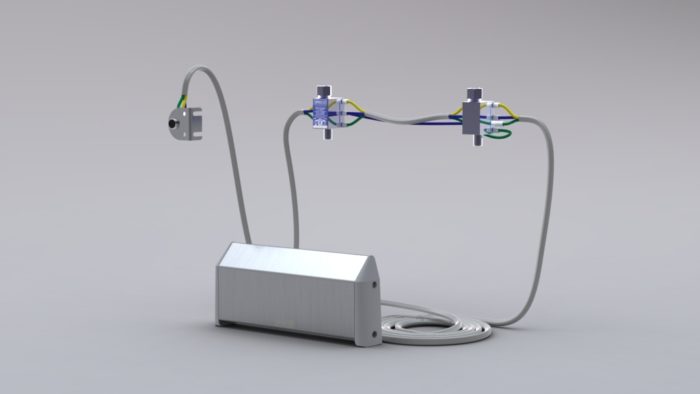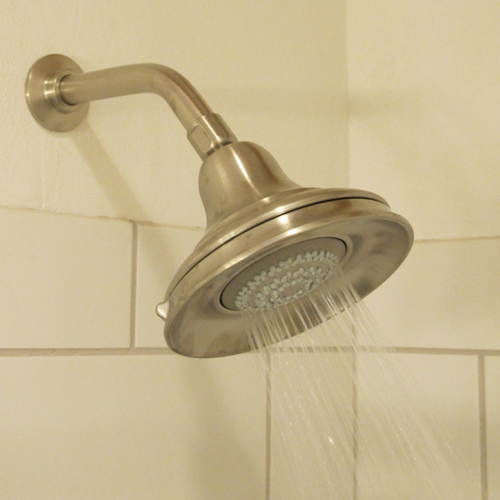Image Credit: Tapmaster
Image Credit: Tapmaster Shown here is a Tapmaster kick-plate for Model 1750 or 1751; Kick-plates are available in black, white, and stainless steel.
Image Credit: Tapmaster
For the past eight years we’ve been able to turn our kitchen faucet on and off using a knee- and foot-controlled valve from the Canadian company Tapmaster. This may seem like a convenience-only product designed for lazy people. I can’t argue with all of that — and admit that I probably wouldn’t have installed one if I hadn’t received it for testing from the manufacturer after we had reviewed a competing product in Environmental Building News. But I gotta say, I love it, and I’m convinced that it does result in significant water and energy savings.
Foot and knee controls for faucets have been used for decades in hospitals, where doctors and nurses don’t want to risk re-contaminating their hands by touching the faucet handle after washing. Now these controls are making their way into high-end homes as a convenience feature (as are sensor-activated controls), and our company has recommended this type of product since our first review of a foot-controlled faucet in 1999 (log-in required to read full article).
With foot- and knee-controls for faucets, you set the desired temperature and flow rate using the standard hot and cold levers. Then you turn the tap on and off by pushing an under-sink cabinet door with your knee, by stepping on a foot valve, or by depressing a “kick-plate” beneath the cabinet. Our particular model allows us to use either a knee against the cabinet door or the tip of a foot pushing against a kick-plate. To adjust the rate of flow or the temperature, one simply adjusts the levers like normal — but you turn the flow off by releasing pressure on the cabinet door or foot pad.
We usually have only the cold water lever turned on (to quickly fill a water glass or rinse a spoon off during the day). When we’re going to wash dishes, we simply turn off the cold lever and turn on the hot (because we keep our water heater set to about 120°F, we usually don’t have to mix cold with hot for washing dishes).
It’s certainly a convenience to turn the water on and off without using your hands. But it also saves water. This morning, when I was filling the water bowl for our golden retriever, for example, I was able to hold the bowl with both hands and not waste water by turning on the faucet and then lifting the bowl under the tap. When washing pots and pans, with the hot-water tap turned on, I control the flow very simply using my knee, while many people leave the water running.
While you save water whether it’s hot or cold water that’s being controlled, there’s a whole lot more money to be saved by reducing use of hot water, because it’s water that doesn’t have to be heated.
The biggest problem we have is when guests are over and can’t figure out how to turn on the water. For this reason, we often lock the control in the “on” position (a simple process using the kick-plate) so that the flow is controlled with the faucet levers — like normal. Our younger daughter used to enjoy tricking her friends, though, by snapping her fingers as she surreptitiously pushed in the cabinet door or foot pad. Her friends would try to turn on the tap by snapping their fingers….
Tapmaster’s foot- and knee-control systems start at about $300 (not including installation), with some systems costing over $500. Would I recommend this as starting-point investment in water and energy savings? Certainly not. But, I have to say that after using one of these for eight years (with absolutely no problem), if I were building a new house today I would figure out a way to work this feature into the budget.
In addition to this Energy Solutions blog, Alex contributes to the weekly blog BuildingGreen’s Product of the Week, which profiles an interesting new green building product each week. You can sign up to receive notices of these blogs by e-mail — enter your e-mail address in the upper right corner of any blog page.
Alex is founder of BuildingGreen, Inc. and executive editor of Environmental Building News. To keep up with his latest articles and musings, you can sign up for his Twitter feed.
Weekly Newsletter
Get building science and energy efficiency advice, plus special offers, in your inbox.













2 Comments
Pedal Valves
I saw one of these about 20 years ago at a veterinarian's office and was sold on the concept. I went looking recently for a contemporary example and found the manufacturer below. I have never installed one.
http://www.pedalvalve.com/
Surprised these are not more popular
We tried a foot control and found that it was both really convenient and great at cutting our water usage. Think of how many times you turn water on and off scrubbing a pot. We have more details at http://www.wholebuffalo.com/reviews/low+flow+faucets/ About the only negative is that it is a little confusing for guests.
Log in or create an account to post a comment.
Sign up Log in